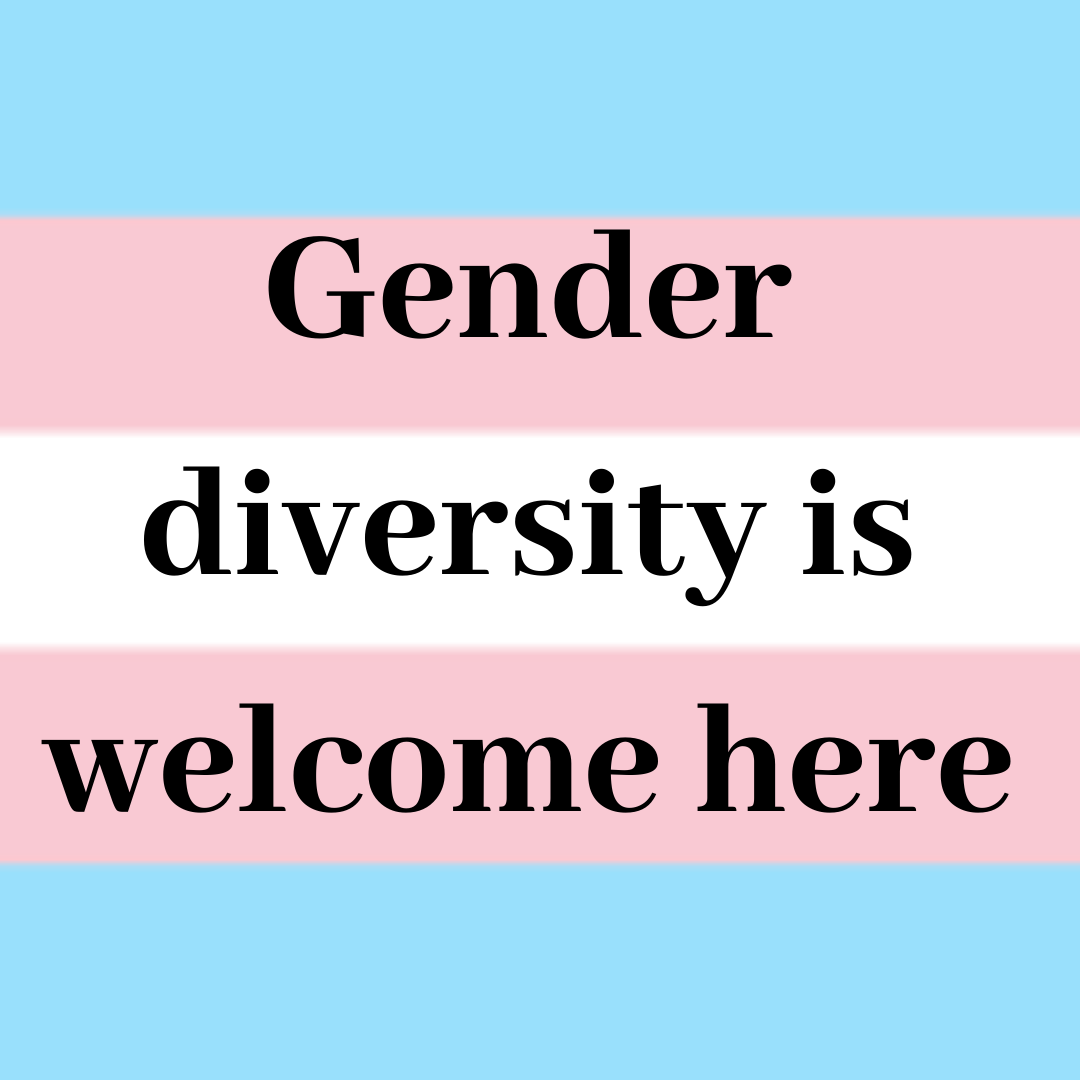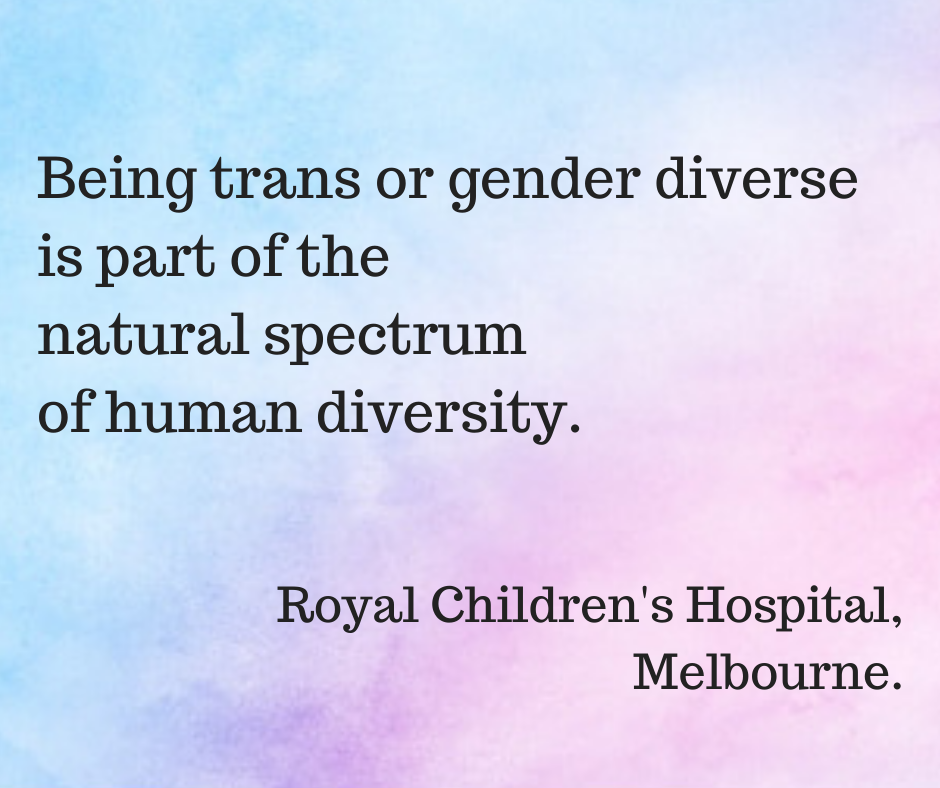We can all support TGDNB students.
Whether we are teachers, parents or students, we can all do things to make schools safe and supportive places for trans, gender diverse and non-binary (TGDNB) students.
Educate ourselves and our children about gender diversity.
Answering questions about gender diversity can be intrusive and exhausting for gender diverse students and their families, so try to use other sources of information as much as possible - and the internet has plenty! Here are some things to get you started:
Trans 101 is a brilliant series of short videos and booklets created by Ygender and Minus18. (If you are pressed for time, the first video ‘The Basics’ covers central issues in about 8 minutes.) The Trevor Project also has a great booklet, called Guide to Being an Ally to Trans and Non-Binary Youth.
First Day (rated PG), is a great new 4-part ABC Kids drama (rated PG), currently available on iview. It is about a 12-year old transgender schoolgirl (played by trans actor and activist, Evie McDonald) who must manage all the usual challenges of starting high school, in addition to the challenges of being transgender.
Queer Kid Stuff is a youtube channel with amazing short videos for pre-school and young primary school kids, about “LGBTQ+ and social justice issues for all ages”. They have a number of short videos for pre-school to primary kids about being transgender, gender and gender expression. (There is even a puppet!)
This tip sheet (from Welcoming Schools) has a range of simple statements that children and adults can use to respond to questions and negative comments about gender expression and gender stereotypes.
The Rainbow Owl has great suggestions for books and resources on embracing and supporting trans and gender diverse young people, for children of all ages, for parents and professionals. Some favourites include It Feels Good to be Yourself, Introducing Teddy, (here read aloud by the author!!), I Am Jazz and From The Stars In The Sky to the Fish in the Sea.
There are some fantastic organisations in Victoria that support trans, gender diverse and non-binary young people, such as Transcend, Parents of Gender Diverse Children, Ygender and Minus18. Check out their websites for information, and like and follow them on social media.
Show our support and challenge negative comments.
One of the most powerful things you can do as an ally, is to show it.
Tell people you know to be trans, gender diverse or non-binary that you are on their side, and that you are a safe person to come to if they are feeling threatened or stressed. Ask them what you can do to help make school a better place for them.
Grab some trans badges, stickers, lanyards or flags, and wear them to school to show your support. These small gestures are very powerful. Minus18 has some great trans merchandise, as does ebay, of course!
Print out some posters and put them up in your front windows at home.
Show your support on social media by sharing content from organisations that support trans, gender diverse and non-binary young people, such as Transcend, Parents of Gender Diverse Children, Raising My Rainbow, Ygender and Minus18.
Challenging negative comments is very important, as is making sure that school leadership know that they are occurring.
Unfortunately, some kids and adults may not understand gender diversity, and the anti-discrimination laws and inclusion and anti-bullying policies that protect TGDNB people. So they may make negative comments, or ‘jokes’. These might include making fun of someone’s appearance or gender identity, telling someone they are not “really” the gender with which they identify, saying that they cannot use the toilet aligning with that identity, or asking inappropriate questions about student’s bodies.
Where it is safe to do so, it is important to let the speaker know that these comments are inappropriate and harmful. If it is a child speaking, you might suggest they speak to a teacher about gender diversity, and point out that their comments might breach the school inclusion and anti-bullying policies. If it is an adult, you might suggest they speak to the principal or the DET, if they have questions about policy and legal requirements.
This tip sheet (from Welcoming Schools) has a range of simple statements that children and adults can use to respond to questions and negative comments about gender expression and gender stereotypes.
Another useful response to teach kids is, “it is not ok to say or ask that, you should talk to your teacher so you can understand why.”
Help make change happen at school.
While the Department of Education in Victoria has clear directives that schools must be inclusive, respectful and supportive/affirming places for TGDNB students, in reality it is rare for schools to make the required changes without strong and sustained advocacy from TGDNB students and/or their families.
The more other students and families show their support, the quicker change happens, and the less this work falls on TGDNB students and families.
So, how to help?
Send a brief email to the school, expressing your support for any measures they have taken so far to support TGDNB students. You could also suggest some future measures, like an information evening for parents about gender diversity, or informative posters around the school explaining aspects of gender diversity such as the use of pronouns. If you are aware of any negative comments about gender diversity from students, staff or parents/carers, it is important to let the school know, so that they can take action.
Reach out to the TGDNB student and family. If you or your child is friends with a TGDNB student or family, then let them know that you support gender diversity, and and ask what you could do to help. This might be reading a draft of an email to the school, talking to school about your support for proposed changes, being a safe place for them to vent or let off steam, or taking the kids for an afternoon. Your child may wish to volunteer themselves as a safe person at school, for the TGDNB student to come to if they are feeling stressed or unsafe. Knowing that other students and families understand something about issues and the stress that they are under can make an enormous difference to TGDNB students and families.
What are schools required to do to support TGDNB students, and to what extent does this actually happen?
The Victorian Department of Education and Training’s (DET) policy on Gender Diversity is very strong, requiring schools to make numerous changes to support TGDNB students to transition or affirm their gender identity at school. But the reality is that schools rarely prioritise these changes without strong and sustained advocacy from TGDNB students and/or their families, which is an exhausting and stressful process.
The DET policy has many requirements for schools, including the following:
develop a gender affirmation support plan with the student and parents/caregivers, which includes how the student will be supported by teachers and leadership.
ensure that their policies, practices and activities are inclusive and do not treat any student unfavourably because of their sexual orientation, gender identity or intersex status. This includes those applying to toilets/change rooms, uniforms, and sport team membership.
take positive action to eliminate discrimination or harassment.
The Safe Schools Program is also available to help schools combat homophobia and transphobia and create inclusive school environments. In Victoria, this is a requirement for all secondary schools, and optional for primary schools.
But these changes take time and resources, which is why schools rarely prioritise them without strong, sustained advocacy from a TGDNB student or their family, which is usually a very stressful process.
Meanwhile every TGDNB student at the school is required to function within a school that is not meeting its requirements to provide them with a safe and affirming place to focus on their learning.
So we need to ask schools to start making these changes to policies and procedures right now, so that our schools are a safe and welcoming place for all students.






